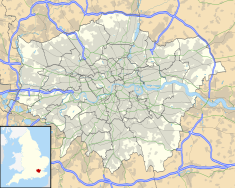Winchester Palace
| Winchester Hall | |
|---|---|

Remains of the great hall of Winchester Palace showing the Rose Window and underneath the traditional arrangement of three doors from the screens passage to the buttery, pantry and kitchen.
|
|
| Location |
Clink Street London, SE1 United Kingdom |
| Coordinates | 51°30′25″N 0°05′27″W / 51.50683°N 0.09092°WCoordinates: 51°30′25″N 0°05′27″W / 51.50683°N 0.09092°W |
| Built | 12th century |
| Architectural style(s) |
Medieval Tudor |
| Governing body | English Heritage |
| Reference no. | Grade II |
Winchester Palace was a 12th-century palace which served as the London townhouse of the Bishops of Winchester. It was located on the south bank of the River Thames in what is now the London Borough of Southwark, near the medieval priory which later became Southwark Cathedral. Remains of the demolished palace survive on the site today.
Southwark in the county of Surrey was formerly the largest manor in the Diocese of Winchester and the Bishop of Winchester was a major landowner in the area. He was a great power in the land, and traditionally served as the king's royal treasurer, performing the function of the modern Chancellor of the Exchequer. He thus frequently needed to attend the king both at his court in Westminster, at the Tower of London and also was required to attend Parliament with other bishops and major abbots. The city of Winchester had been the capital of the Saxon kings of England. For that purpose, Henry of Blois built the palace as his comfortable and high-status London residence. Most of the other English bishops similarly had episcopal palaces in London, most notably Lambeth Palace, residence of the Archbishop of Canterbury.
The palace remained in use until the 17th century, when it was divided into tenements and warehouses, but was mostly destroyed by fire in 1814. Part of the great hall, and the west gable end with its rose window became more visible after a 19th-century fire and 20th-century redevelopment. It is believed that the great hall was built in about 1136.
...
Wikipedia

